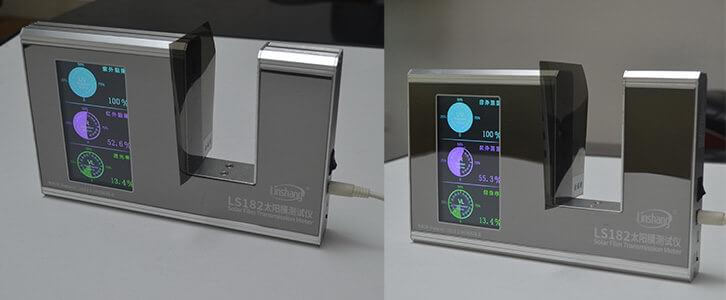Difference between Metal Film and Decalescence Film | window tint detector
The current automotive solar film can be divided into different types according to different production processes. But in general, it is inseparable from the amount of heat insulation and ultraviolet rays. Window tint detector is a special instrument used to detect the transmittance, ultraviolet rejection rate and infrared rejection rate of solar film. Since the common solar film can be divided into two types, the window tint detector also can be divided into two types. One is more suitable for metal film and the other one is more suitable for decalescence film. So what is the difference between these two types of solar film?
According to the thermal insulation principle, the solar film can be divided into reflective film and decalescence film. The reflective film is mainly insulated by reflecting infrared rays, while the decalescence film is insulated by absorbing heat from the film itself.
According to the material, the solar film can be divided into metal film and non-metal film. The metal film is what we often call the magnetron sputtering metal film. In short, metal particles are sputtered onto the film at high speed in a magnetic field. Multiple layers of different metal particles block light in different wavelength bands. Most of the reflective films are metal films, which have better heat control. But it will affect mobile phones, ETC and GPS signals. Non-metallic films are mainly decalescence films, but excessive heat absorption can easily cause the temperature of automobile glass to rise faster.
Linshang Technology has independently developed and produced window tint detector since 2008. Based on many years of experience, we have found that most metal films have a good barrier to infrared rays at 1400 nm, while decalescence films have a good barrier to infrared rays at 940 nm. So, we invented window tint detectors for two different light sources. Of course, both instruments are suitable for any kind of solar film and the measured values are also accurate. If you need to measure the infrared rejection rate of a film for two wavebands at the same time, we also have a versatile window tint detector LS182, which can measure the average value of two infrared rejection rates at the same time. When comparing the comprehensive performance of the film, The data is more comprehensive and objective.
In addition to metal films and decalescence films, there is also a more common type of ceramic film. Since ceramic films are also different types, we also recommend that customers understand the production process of the film before selecting the instrument. Or you can send film samples to us. We can arrange the test for you and send you the data after testing. Then you choose the most suitable window tint detector.
- Choosing the Right Window Tinting Film
- Window Tint Meter | Pros and Selection Methods of Architectural Membrane
- Advantages of LS110H and LS110A Split Transmission Meter
- Best Choice:LS182 Solar Film Transmission Meter
- Solar Power Lightens Up with Thin-Film Technology
- What is the Solar Heat Gain Coefficient Ratings (SHGC)

